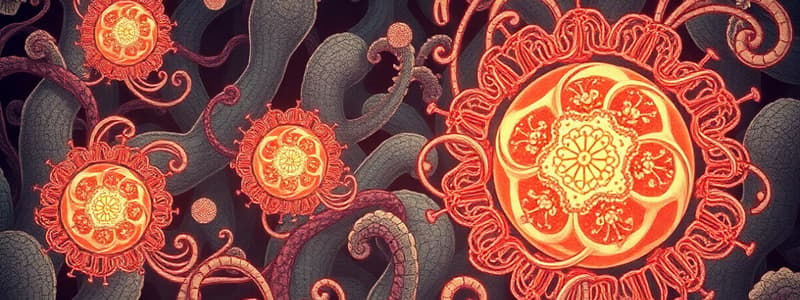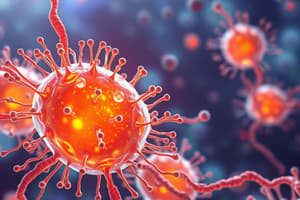Podcast
Questions and Answers
What is the structure of glycogen granules as observed under TEM?
What is the structure of glycogen granules as observed under TEM?
- Spherical electron dense granules surrounded by a membrane
- Cylindrical granules with a limiting membrane
- Flat, irregular shaped granules with variable density
- Rosette shaped electron dense granules (correct)
What distinguishes secretory granules as per their structural properties?
What distinguishes secretory granules as per their structural properties?
- Unique flat shape with no membrane
- Array of colorful granules with diverse functions
- Variable size and surrounded by a membrane (correct)
- Homogeneous size and membrane presence
What does the term 'singlet ring appearance' refer to in tissue histology?
What does the term 'singlet ring appearance' refer to in tissue histology?
- The arrangement of collagen fibers in connective tissue
- The unique color staining method used for cells
- The morphology of adipose connective tissue cells (correct)
- The structural arrangement of blood vessels
What type of staining is used for visualizing fat cells in histology?
What type of staining is used for visualizing fat cells in histology?
What is the distinguishing feature of lipid droplets as seen under TEM?
What is the distinguishing feature of lipid droplets as seen under TEM?
Which of the following is NOT a non-membranous organelle?
Which of the following is NOT a non-membranous organelle?
What is the histological appearance of ribosomes when examined using light microscopy?
What is the histological appearance of ribosomes when examined using light microscopy?
Which cytoplasmic structure functions as part of the cytoskeleton in cells?
Which cytoplasmic structure functions as part of the cytoskeleton in cells?
What type of structure do centrioles consist of?
What type of structure do centrioles consist of?
Which technique is used to visualize microtubules in cells?
Which technique is used to visualize microtubules in cells?
In which cellular structures are microtubules found primarily?
In which cellular structures are microtubules found primarily?
What characterizes the structure of microtubules in transverse section (T.S)?
What characterizes the structure of microtubules in transverse section (T.S)?
Which statement is true about the function of microtubules?
Which statement is true about the function of microtubules?
What is the structure that forms the central component of the shaft of a cilium?
What is the structure that forms the central component of the shaft of a cilium?
Which of the following is NOT a component of cilia?
Which of the following is NOT a component of cilia?
How many triplet microtubules form the wall of a centriole?
How many triplet microtubules form the wall of a centriole?
What is the diameter range of thin filaments in the cytoskeleton?
What is the diameter range of thin filaments in the cytoskeleton?
Cilia help in spreading a thin film of which substance across a surface?
Cilia help in spreading a thin film of which substance across a surface?
Which component is NOT part of the structure of the cilium?
Which component is NOT part of the structure of the cilium?
What type of substances can cell inclusions include?
What type of substances can cell inclusions include?
What is the main function of the microvilli?
What is the main function of the microvilli?
Flashcards are hidden until you start studying
Study Notes
Non-membranous Organelles
- Non-membranous organelles don't have a membrane surrounding them.
- They are comprised of:
- Ribosomes
- Microtubules
- Centrioles
- Cilia and flagella
- Cell Filaments
Ribosomes
- Small, non-membranous, dynamic organelles found free or attached to the rough endoplasmic reticulum (rER).
- Can be identified at the light microscope (LM) level by the basophilia of the cytoplasm.
- This basophilia can be:
- Diffuse: Spread throughout the cytoplasm
- Localized: Contained within specific areas
- This basophilia can be:
- Can be identified at the electron microscope (EM) level by their electron-dense granules.
- These granules appear free in the cytoplasm or attached to rER.
- Polyribosomes: Ribosomes attached together by mRNA, forming whorl-like figures.
Microtubules
- Non-membranous organelles present in all cells, particularly where stiffness, shape, or oriented motion is required.
- Found in: blood platelets, cilia, flagella, mitotic spindle, etc.
- Identified at the LM level as filaments after using immunofluorescent staining techniques.
- Identified at the EM level as long, straight, cylindrical, non-branching structures (longitudinal section).
- The wall of a microtubule is composed of 13 protofilaments (transverse section).
- Microtubule diameter remains constant.
- Functions:
- Cytoskeleton of the cell
- Formation of the mitotic spindle
- Formation of centrioles and the axoneme of cilia and flagella
- Movement of organelles and vesicles in the cytoplasm
Centrioles
- Non-membranous organoids present near the nucleus and Golgi apparatus in all cells except red blood cells and nerve cells (which don't divide).
- Identified at the EM level as a short cylinder with a wall composed of 9 triplets of microtubules.
- Each triplet is formed from 3 microtubules (a, b, and c).
- Microtubule a is formed of 13 protofilaments, while b and c are formed of 10 protofilaments.
- Each triplet is formed from 3 microtubules (a, b, and c).
Cilia
- Elongated, motile structures that extend from the free cell surface.
- Present in ciliated epithelium.
- Identified at the LM level as short, fine, hair-like processes arising from the free cell surface.
- Identified at the EM level as outgrowths of the cells covered by a plasma membrane.
- Each cilium is comprised of:
- Basal body: A centriole that has migrated to near the cell surface.
- Shaft (axoneme): Formed of two single microtubules in the center and nine paired (doublets) microtubulues arranged circularly around the periphery.
- Rootlets: Extend from the deep aspect of the basal body.
- Basal foot: Attached laterally to the basal body.
- Functions:
- Spreading a thin film of fluid or mucus across a surface.
- Modified to receive stimuli (light stimuli in rods and cones of the retina).
Flagella
- Resemble cilia but are longer and usually present as a single structure.
Cell Filaments
- Classified based on diameter:
- Thick Filaments: 10-15 nm, such as myosin filaments.
- Intermediate filaments: 8-10 nm, such as neurofilaments.
- Thin filaments: 6-8 nm, such as actin filaments.
Cell Inclusions
- Temporary constituents of the cell.
- Can be:
- Nutritive substances: Proteins (secretory granules), carbohydrates (glycogen), and fats (lipid droplets).
- Pigments: Endogenous (melanin, hemoglobin, hemoglobin derivatives such as hemosiderin, lipofuscin) and exogenous (carbon, tattoo particles).
- Crystalloids: E.g., present in Sertoli cells.
Learning Objectives
- Enumerate non-membranous organelles.
- Identify the histological structure of ribosomes at the LM and EM levels.
- Describe the histological structure of microtubules at the EM level.
- Identify the histological structure of centrioles at the EM level.
- Describe the histological structure of cilia at the LM and EM levels.
- Identify the histological structure of microvilli at the LM and EM levels.
- Identify different types of cell inclusions.
Studying That Suits You
Use AI to generate personalized quizzes and flashcards to suit your learning preferences.




